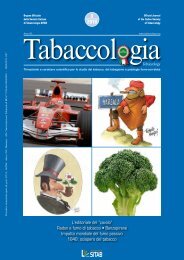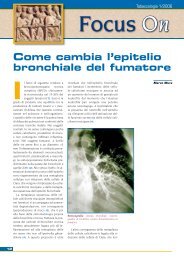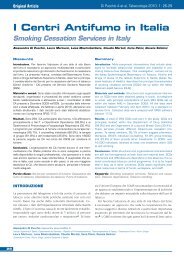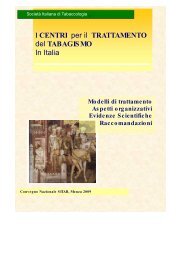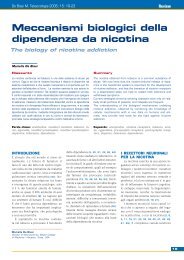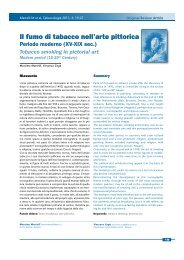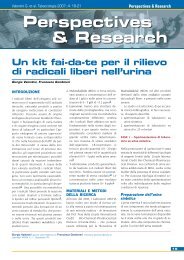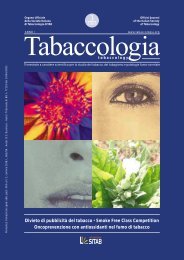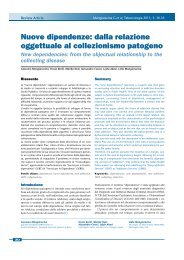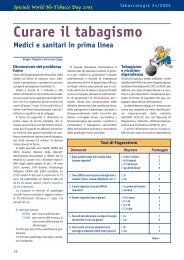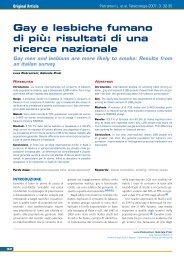Scarica n. 1/2011 - Società Italiana di Tabaccologia
Scarica n. 1/2011 - Società Italiana di Tabaccologia
Scarica n. 1/2011 - Società Italiana di Tabaccologia
You also want an ePaper? Increase the reach of your titles
YUMPU automatically turns print PDFs into web optimized ePapers that Google loves.
2<br />
Norme redazionali<br />
<strong>Tabaccologia</strong> (Tobaccology) è l’organo ufficiale della <strong>Società</strong> <strong>Italiana</strong> <strong>di</strong> <strong>Tabaccologia</strong> (SITAB) ed è una<br />
rivista me<strong>di</strong>ca. Viene pubblicato con cadenza trimestrale, più gli eventuali supplementi. Vengono pubblicati<br />
E<strong>di</strong>toriali, Articoli Originali, Rassegne, Stati dell’Arte, “Focus on”, “Perspective&Research”, Opinioni,<br />
Abstracts e Lettere su argomenti legati al tabacco, patologie indotte dal tabacco, <strong>di</strong>pendenza dal fumo e sua<br />
prevenzione. Tutti gli articoli devono essere inviati in formato Microsoft Word via e-mail all’in<strong>di</strong>rizzo redazione@tabaccologia.it.<br />
Le Figure devono essere inviate in file separati in formato Powerpoint, TIF o JPG.<br />
Il testo deve essere in formato Times New Roman con doppia spaziatura. Le pagine devono essere numerate<br />
in fondo a ciascuna. Tutti gli articoli non invitati vengono inviati al processo <strong>di</strong> peer-review dall’E<strong>di</strong>tor.<br />
Tutte le comunicazioni inerenti gli articoli inviati a <strong>Tabaccologia</strong> avvengono via e-mail. Gli autori degli<br />
articoli accettati per la pubblicazione dovranno firmare un modulo col quale trasferiscono i copyright a<br />
<strong>Tabaccologia</strong>.<br />
Articoli Originali e Rassegne: vengono considerati per la pubblicazioni articoli in italiano ed in inglese.<br />
Gli articoli in italiano devono presentare il titolo, il riassunto (summary) e le parole chiave anche in inglese.<br />
Gli articoli in inglese verranno tradotti in italiano a cura della redazione.<br />
La prima pagina del manoscritto deve includere a) il titolo dell’articolo in italiano ed in inglese; b) i nomi<br />
degli autori; c) le istituzioni degli autori; d) l’in<strong>di</strong>rizzo <strong>di</strong> posta or<strong>di</strong>naria, i numeri <strong>di</strong> telefono e fax e l’in<strong>di</strong>rizzo<br />
e-mail del correspon<strong>di</strong>ng author.<br />
La seconda pagina degli Articoli Originali e delle Rassegne deve includere il riassunto (abstract) e dalle 3<br />
alle 5 parole chiave. Il riassunto non deve eccedere le 250 parole. Il riassunto degli Articoli Originali deve<br />
essere strutturato nei seguenti paragrafi: Introduzione, Meto<strong>di</strong>, Risultati, Conclusioni. A seguire il summary<br />
in inglese, che nel caso degli Articoli Originali deve essere così strutturato: Introduction, Methods, Results,<br />
Conclusions e dalle 3 alle 5 keywords.<br />
Il corpo del manoscritto segue dalla terza pagina. Non vi sono limiti <strong>di</strong> parole per gli articoli, ad eccezione<br />
degli E<strong>di</strong>toriali, che non devono eccedere le 800 parole. Gli Articoli Originali devono essere strutturati<br />
nei seguenti paragrafi: Introduzione; Meto<strong>di</strong>; Risultati; Discussione; Conclusioni. Le Conclusioni devono<br />
essere presenti anche nelle Rassegne.<br />
Gli Articoli Originali che includono qualsiasi procedura <strong>di</strong>agnostica o terapeutica su esseri umani devono<br />
chiaramente in<strong>di</strong>care nei “Meto<strong>di</strong>” sotto la responsabilità degli autori che il consenso informato è stato<br />
ottenuto da tutti i soggetti inclusi nello stu<strong>di</strong>o.<br />
Gli Articoli Originali che includono esperimenti su esseri umani o animali devono in<strong>di</strong>care sotto la responsabilità<br />
degli autori nei “Meto<strong>di</strong>” che tutti gli esperimenti sono stati condotti in accordo con gli standard<br />
etici stabiliti dal comitato etico istituzionale o nazionale e con la Dichiarazione <strong>di</strong> Helsinki del 1975,<br />
revisionata nel 2000. Se esistono dubbi circa l’aderenza agli standard della Dichiarazione <strong>di</strong> Helsinki, gli<br />
autori devono spiegare il razionale del loro approccio, e <strong>di</strong>mostrare che il comitato etico istituzionale ha<br />
esplicitamente approvato gli aspetti dubbi dello stu<strong>di</strong>o. Quando vengono riportati esperimenti su animali,<br />
gli autori devono in<strong>di</strong>care quale guida istituzionale o nazionale hanno seguito per il trattamento e<br />
l’utilizzo degli animali in laboratorio.<br />
Alla fine del corpo del manoscritto gli autori devono in<strong>di</strong>care i seguenti punti:<br />
1) Conflitto <strong>di</strong> interessi: tutti gli autori devono in<strong>di</strong>care eventuali conflitti <strong>di</strong> interessi. Un conflitto <strong>di</strong><br />
interessi si verifica quando un autore (o l’istituzione <strong>di</strong> un autore) ha una relazione finanziaria o personale<br />
che influenza in maniera inappropriata (bias) la sua condotta (queste relazioni sono anche conosciute come<br />
commitments, competing interests, o competing loyalties). Queste relazioni variano da quelle con potenziale<br />
trascurabile a quelle con grande potenziale <strong>di</strong> influenzare il giu<strong>di</strong>zio, e non tutte le relazioni rappresentano<br />
un vero conflitto <strong>di</strong> interessi. Il potenziale <strong>di</strong> un conflitto <strong>di</strong> interessi può esistere anche quando l’autore<br />
non ritenga che la relazione influenzi il suo giu<strong>di</strong>zio scientifico. Le relazioni <strong>di</strong> natura finanziaria (come<br />
impiego, consulenze, possesso <strong>di</strong> azioni, pagamento <strong>di</strong> onorari, testimonianze <strong>di</strong> esperto retribuite) rappresentano<br />
i conflitti <strong>di</strong> interessi più facilmente identificabili e quelli che più probabilmente possono minare<br />
la cre<strong>di</strong>bilità della rivista, degli autori e della scienza stessa. Tuttavia, i conflitti <strong>di</strong> interessi possono avvenire<br />
anche per altre ragioni, come relazioni personali, competizione accademica e passione intellettuale.<br />
2) Fonti <strong>di</strong> finanziamento: (solo per gli Articoli Originali): tutte le fonti <strong>di</strong> finanziamento devono essere<br />
<strong>di</strong>chiarate dagli autori. <strong>Tabaccologia</strong> applica un embargo a tutti i lavori che abbiano ricevuto finanziamenti<br />
dalle industrie e compagnie del tabacco. Pertanto tali articoli non verranno considerati per la pubblicazione.<br />
Bibliografia: Dopo il manoscritto devono essere in<strong>di</strong>cate le referenze citate, come in or<strong>di</strong>ne <strong>di</strong> apparizione<br />
nel testo. Nel testo, il numero <strong>di</strong> ogni referenza deve essere in<strong>di</strong>cato dentro parentesi quadra. Non vi sono<br />
limiti per il numero <strong>di</strong> referenze citate. Gli articoli <strong>di</strong> riviste devono in<strong>di</strong>care: il cognome e le iniziali<br />
del nome degli autori (al massimo 6), il titolo completo dell’articolo in lingua originale, le informazioni<br />
abbreviate sulla rivista, in accordo con il Me<strong>di</strong>cal Index, l’anno <strong>di</strong> pubblicazione, il volume e le pagine <strong>di</strong><br />
inizio e fine. Per esempio: Stanton WR, Oei TPS, Silva PA. Sociodemographic characteristics of adolescent<br />
smokers. Int J Ad<strong>di</strong>ction 1994; 29: 913-925.<br />
I capitoli <strong>di</strong> libri devono in<strong>di</strong>care il cognome e le iniziali del nome degli autori, il titolo del capitolo, il<br />
cognome e le iniziali del nome degli autori del libro, la casa e<strong>di</strong>trice, il luogo e l’anno <strong>di</strong> pubblicazione.<br />
Per esempio: Murphy DM, Fishman AP. Bullous <strong>di</strong>seases of the lung. In: Fishman AP, Pulmonary <strong>di</strong>seases.<br />
McGraw-Hill, New York, 1998.<br />
I siti web citati devono in<strong>di</strong>care il titolo del soggetto e l’in<strong>di</strong>rizzo web. Per esempio:<br />
Carbon monoxide - Environmental Health Center, National Safety Council: www.nsc.org/ehc/indoor/<br />
carb_mon.htm<br />
Le Tabelle e le legende delle Figure devono seguire il corpo del manoscritto e devono essere numerate consecutivamente.<br />
Le Figure devono essere inviate in file separati e devono essere in formato Powerpoint, TIF o JPG.<br />
<strong>Tabaccologia</strong> si riserva il <strong>di</strong>ritto <strong>di</strong> apportare cambiamenti nel testo. Gli articoli non redatti secondo queste<br />
istruzioni non verranno considerati per la pubblicazione.<br />
Segreteria <strong>di</strong> redazione e marketing: Alessandra Cavazzi<br />
E-mail:<br />
Come ricevere la rivista<br />
a) Tramite abbonamento <strong>di</strong> € 40,00 da versare con bonifico bancario alle seguenti coor<strong>di</strong>nate bancarie:<br />
Banca CREDEM <strong>di</strong> Bologna, Agenzia 2, c/c 010000001062; CAB: 02401; ABI: 03032; IBAN:<br />
IT02U0303202401010000001062<br />
b) Diventando un socio SITAB, a cui la rivista <strong>Tabaccologia</strong> viene inviata per posta or<strong>di</strong>naria.<br />
Come <strong>di</strong>ventare membro della SITAB<br />
L’iscrizione alla SITAB per il 2012 è <strong>di</strong> € 50,00 (€ 25,00 per infermieri, laurean<strong>di</strong>, specializzan<strong>di</strong>, dottoran<strong>di</strong>,<br />
personale del comparto). Il pagamento può essere fatto con bonifico alle seguenti coor<strong>di</strong>nate<br />
bancarie: Banca CREDEM <strong>di</strong> Bologna, Agenzia 2, c/c 010000001062; CAB: 02401; ABI: 03032; IBAN:<br />
IT02U0303202401010000001062<br />
Il modulo <strong>di</strong> iscrizione deve inoltre essere scaricato dal sito web www.tabaccologia.org ed inviato alla<br />
dott.ssa Nolita Pulerà:<br />
• per posta or<strong>di</strong>naria: Centro Tabagismo, Ospedale Livorno, Viale Alfieri 36, 51100, Livorno<br />
• per fax: 0586 22.30.06<br />
• per e-mail:<br />
<strong>Tabaccologia</strong> 1/<strong>2011</strong><br />
Istruzioni per gli Autori Instructions to Authors<br />
<strong>Tabaccologia</strong> (Tobaccology) is the official body of the Italian Society of Tobaccology (SITAB) and is a<br />
me<strong>di</strong>cal journal. Four issues per year plus supplements are published. E<strong>di</strong>torials, Original Articles, Reviews,<br />
“Focus on” and “Perspective&Research” about subjects related with tobacco, tobaccology, tobacco-induced<br />
pathologies, smoke ad<strong>di</strong>tion and prevention are considered for publication. All contributions must be sent<br />
in Microsoft Word format by e-mail to redazione@tabaccologia.it. Images should be sent in separate files<br />
in Powerpoint, TIF, or JPG format.<br />
Texts should be in Times New Roman format and double-spaced. Pages should be enumerated at the<br />
bottom of each page.<br />
All non-invited contributions will be sent for peer-review by the E<strong>di</strong>tor. All correspondences regar<strong>di</strong>ng<br />
submitted manuscripts will take place by e-mail. The authors of articles accepted for publication will be<br />
asked to sign a form where they transfer the copyright of their article to <strong>Tabaccologia</strong>.<br />
Original Articles in Italian and English languages are considered for publication. For articles in Italian:<br />
title, abstract and key words in English must be provided as well. Articles in English will be translated into<br />
Italian by the e<strong>di</strong>torial office.<br />
The first page of the manuscript should include a) the title of the article both in Italian and in English;<br />
b) authors’ names; c) authors’ institution(s); d) mail address, telephone, fax and e-mail address of the<br />
correspon<strong>di</strong>ng author.<br />
The second page of Original Articles and Reviews should include the summary (abstract) and 3 to 5 key<br />
words. The summary should not exceed 250 words. The summary of Original Articles should be structured<br />
in the following paragraphs: Introduction, Methods, Results, Conclusions. Then, the summary in English.<br />
In the Original Articles it must be structured in the following way: Introduction, Methods, Results, Conclusions<br />
and 3 to 5 keywords.<br />
The manuscript body follows from the third page. There is no word limit for articles, exept for E<strong>di</strong>torials,<br />
which should not exceed 800 words. Original Articles should be structured as follows: Introduction;<br />
Methods; Results; Discussion; Conclusions. Conclusions should be provided for Review articles as well.<br />
Original Articles that include any <strong>di</strong>agnostic or therapeutic procedure on humans must clearly state under<br />
the authors’ responsability in the “Methods” section that informed consent has been obtained by all<br />
subjects included in the study.<br />
Original Articles that include experiments on humans or animals must state under the authors’ responsibility<br />
in the “Methods” section that all experiments have been carried out in accordance with the ethical<br />
standards of the responsible committee on human experimentation (institutional and national) and with<br />
the Helsinki Declaration of 1975, revised in 2000. If doubt exists whether the research was accomplished<br />
in accordance with the Helsinki Declaration, the authors must explain the rationale for their approach,<br />
and demonstrate that the institutional review body explicitly approved the doubtful aspects of the study.<br />
When reporting experiments on animals, authors should in<strong>di</strong>cate which institutional and national guide<br />
for care and use of laboratory animals was followed.<br />
At the end of the manuscript body the authors must state the following points:<br />
1) Conflict of interest: all authors should state whether any conflict of interest occur. Conflict of interest<br />
exists when an author (or the author’s institution) has financial or personal relationships that inappropriately<br />
influence (bias) his or her actions (such relationships are also known as dual commitments, competing<br />
interests, or competing loyalties). These relationships vary from those with negligible potential to those<br />
with great potential to influence judgement, and not all relationships represent true conflict of interest.<br />
The potential for conflict of interest can exist whether or not an in<strong>di</strong>vidual believes that the relationship<br />
affects his or her scientific judgement. Financial relationships (such as employment, consultancies, stock<br />
ownership, honoraria, paid expert testimony) are the most easily identifiable conflicts of interest and the<br />
most likely to undermine the cre<strong>di</strong>bility of the journal, of the authors and of science itself. However, conflicts<br />
can occur for other reasons, such as personal relationships, academic competition, and intellectual<br />
passion.<br />
2) Source of fun<strong>di</strong>ng (for Original Articles only): All source of fun<strong>di</strong>ng should be stated by the authors.<br />
<strong>Tabaccologia</strong> applies an embargo policy to all contributions that received fun<strong>di</strong>ngs from tobacco industries<br />
and companies. Therefore, these contributions will not be considered for publication.<br />
Bibliography: After the manuscript body, quoted references should be listed in order of appearance in the<br />
text. There is no limit for quoted references. In the text, the number of each reference should be in<strong>di</strong>cated<br />
in square bracket. Quoted journal's articles should in<strong>di</strong>cate: surname and name initials of all authors (max<br />
6), complete title of the article in original language, abbreviated information of the journal accor<strong>di</strong>ng to<br />
the Me<strong>di</strong>cal Index, publication year, volume and pages (the beginning and the end). For example: Stanton<br />
WR, Oei TPS, Silva PA. Sociodemographic characteristics of adolescent smokers. Int J Ad<strong>di</strong>ction 1994; 29:<br />
913-925.<br />
Book chapters should in<strong>di</strong>cate the surname and authors’ initials, the chapter title, surname and initials’<br />
book authors, e<strong>di</strong>tor, place and year of publication. For example: Murphy DM, Fishman AP. Bullous <strong>di</strong>seases<br />
of the lung. In: Fishman AP, Pulmonary <strong>di</strong>seases. McGraw-Hill, New York, 1998.<br />
Websites should in<strong>di</strong>cate the subject title and the web address. For example:<br />
Carbon monoxide - Environmental Health Center, National Safety Council: www.nsc.org/ehc/indoor/<br />
carb_mon.htm<br />
Tables and Images captions should follow the manuscript body and be enumerated consecutively. Images<br />
should be sent in separate files in Powerpoint, TIF, or JPG format.<br />
<strong>Tabaccologia</strong> has the right to provide corrections on the text. Articles not complying with the above instructions<br />
may not be considered for publication.<br />
E<strong>di</strong>torial and marketing secretary: Alessandra Cavazzi<br />
E-mail:<br />
How to to receive the journal<br />
a) Annual subscription is € 40,00 to be sent by bank draft to: Banca CREDEM <strong>di</strong> Bologna, Agenzia 2, Account<br />
n. 010000001062; CAB 02401; ABI 03032; IBAN IT02U0303202401010000001062<br />
b) By becoming member of SITAB. The journal <strong>Tabaccologia</strong> is sent by mail to all members of SITAB.<br />
How to become SITAB member<br />
The SITAB membership fee for 2012 is € 50,00 (€ 25,00 for nurses, undergraduate and post-graduate<br />
students and residents) to be sent by bank draft to: Banca CREDEM Bologna, Agency 2, Account n.<br />
010000001062; CAB 02401; ABI 03032; IBAN IT02U0303202401010000001062<br />
Please also download the membership form from website www.tabaccologia.org and send it to Dr. Nolita<br />
Pulerà:<br />
• by mail: Centro Tabagismo, Ospedale Livorno, Viale Alfieri 36, 51100, Livorno, Italy<br />
• by fax: 0039-0586223006<br />
• by e-mail:



